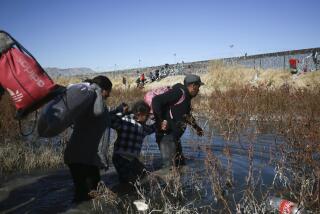Nicaraguan Troop Pullback Told; Fighting Eases
TEGUCIGALPA, Honduras — A border fight between Honduras and Nicaragua appeared to be winding down Monday as U.S. army helicopters ended the job of transporting Honduran troops to a tense sector of the frontier east of here.
There were no reports of new fighting, and a high-ranking Foreign Ministry official said that Sandinista troops from Nicaragua were withdrawing from Honduran territory. One report from the battle area said that Honduran soldiers were pursuing Nicaraguan stragglers.
It was unclear whether Honduran jet fighter-bombers continued to attack Sandinista positions Monday. The A-37 warplanes were apparently the main weapons used against the Sandinistas on Saturday and Sunday, when fighting reportedly broke out.
“We hope that the air attacks will be persuasive with the Nicaraguan army,” said Col. Oscar Flores, spokesman for the Honduran armed forces. A communique Sunday said the bombings will continue until the Sandinistas abandon Honduran territory.
In the Nicaraguan capital of Managua, officials continued to deny any incursions by Sandinista troops into Honduras. The Nicaraguan Defense Ministry issued a communique charging that aircraft from Honduras, which it did not identify, had violated Nicaraguan airspace twice Sunday, penetrating as far as 15 miles into that country’s territory to attack civilian and military targets. (Earlier, Managua had charged that U.S. planes carried out the attacks.)
7 Soldiers Reported Killed
Seven Nicaraguan soldiers were killed in the air raids, the communique said, and 12 soldiers and two children were wounded.
Military officials here denied any violations of Nicaraguan airspace.
“It’s false, it’s false,” Flores said. “It is just Sandinista propaganda.”
Flores offered no concrete information on fighting inside Honduras. He and other Honduran military officials also declined to update casualty figures, which official sources here had placed at 18 Honduran soldiers wounded.
A quick cooling of the outbreak would follow the pattern of a similar confrontation in March, when Honduras, with much fanfare, announced a mobilization of troops against border-crossing Sandinistas. Then, a few days later, the government proclaimed its territory free from the incursionists.
U.S. Pledge of Support
A quick easing of the confrontation reduces the threat of further U.S. involvement. The Reagan Administration has pledged to defend Honduras against its Marxist-led neighbor, and it was in this role that the United States agreed to help transport Honduran troops to the border zone.
“Our activity was essentially to move some soldiers,” said Col. John Fesmire, commander of the American troop detachment stationed at Palmerola air base in Honduras. Several hundred U.S. troops are based at Palmerola.
Fesmire said that on Sunday, U.S. helicopters carried an unspecified number of Honduran soldiers to Jamastran, an American-built dirt airstrip 25 miles west of the scene of the border clash. From there, Honduran helicopters were to have taken the soldiers into battle.
Fesmire said that no Honduran troops were transported by U.S. helicopters Monday, and he added that he did not know if the American aircraft would be needed later to bring the Hondurans back from the area.
In all, four U.S. Chinook helicopters, which carry 33-44 soldiers each, and five UH-1 choppers, with a 11-14 soldier capacity, were used in the operation, Fesmire said, and 60 American crew members participated.
Since the Americans were allowed to go no closer than 25 miles to the hostilities, Fesmire said that no U.S. serviceman was in danger.
Deputy Foreign Minister Roberto Suazo Tome said that fighting with the Nicaraguan troops has ended and that the bulk of the Sandinistas have left this country.
His statement could not be confirmed with Honduran military authorities, who kept secret most facts concerning the situation.
Ramon Castillo, a Honduran congressman, was cautious after a briefing from top government officials.
“Not all the Nicaraguans have cleared out,” Castillo said. “It is still a tense situation.”
Up to 1,000 Nicaraguan soldiers from the Popular Sandinista Army were reported in Honduran territory last week in an area called the Las Vegas salient, where the border between the two nations forms a rough, inverted triangle. The mountainous jungles of the salient are home to thousands of U.S.-supported contras, and in recent months, Nicaraguan forces have frequently pursued the rebels across the border into the Las Vegas area of Honduras.
Until last week, Honduras seemed content to let the Nicaraguans--contras and Sandinistas alike--fight it out among themselves. However, inexplicably, Sandinista troops attacked small Honduran garrisons Thursday and again early Saturday morning.
The Foreign Ministry protested the attacks, first on Friday and then Saturday night.
“I met with the Nicaraguan ambassador,” Suazo Tome said. “He said that no Nicaraguan troops were inside Honduras.
“I said, ‘Good, then you have nothing to worry about. We will be bombing nothing,’ ” Suazo Tome recalled Monday.
More to Read
Sign up for Essential California
The most important California stories and recommendations in your inbox every morning.
You may occasionally receive promotional content from the Los Angeles Times.










